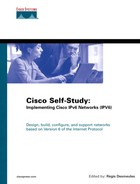Domain Name System (DNS)
The IETF has defined new Domain Name System (DNS) resource record types for IPv6 addresses. This section discusses AAAA and PTR records, which are used for IPv6 addresses in DNS servers.
AAAA Records
In IPv4, the A resource record maps a host name to an IPv4 address. Similarly, the AAAA resource record maps a host name to an IPv6 address. Table 3-9 shows two examples of different resource records using the same fully qualified domain name (FQDN).
| Protocol | Record | DNS Mapping |
|---|---|---|
| IPv4 | A | www.example.org A 206.123.31.200 |
| IPv6 | AAAA | www.example.org AAAA 2001:410:1:1:250:3EFF:FEE4:1 |
The AAAA record has been available since release 4.9.4 of the ISC Berkeley Internet Name Domain (BIND) software. BIND is the DNS server software used by most DNS root server operators; generic Top-Level Domains (gTLDs) such as .com, .net, .org, and so on; and country code Top-Level Domains (ccTLDs).
As with a DNS server that has IPv6 support, it is possible on a limited scale to configure static host names for IPv6 addresses using the command ipv6 host on Cisco routers. Table 3-10 presents examples of the command ipv6 host.
| Command | Description |
|---|---|
| Router(config)#ipv6 host name [port] ipv6-address1 [ipv6-address2 ...] | Defines a static host name-to-IPv6 address mapping. |
| Example RouterA(config)#ipv6 host RouterA 2001:410:0:1:250:3EFF:FEE4:4C00 | Assigns the IPv6 address 2001:410:0:1:250:3EFF:FEE4:4C00 to the host name RouterA. |
| Example RouterA(config)#ipv6 host RouterB FEC0::1:0:0:1:1 | Assigns the IPv6 address FEC0::1:0:0:1:1 to the host name RouterB. |
This command is enabled on a global basis.
The resolver DNS using Cisco IOS Software technology accepts either an IPv6 address or an IPv4 address as a name server. By using the command ip name-server, as shown in Table 3-11, you can specify a DNS server's IPv6 address. Therefore, the router queries this name server using IPv6 as the transport for the name resolution.
| Command | Description |
|---|---|
| Router(config)# ip name-server ipv6-address | Configures the IP address of a DNS server that the router can query. The address may be an IPv4 or IPv6 address. It may accept up to six different name servers. |
| Example RouterA(config)# ip name-server FEC0::1:0:0:1ff:10 | Configures the router to query the name server that can be reached using the IPv6 address FEC0::1:0:0:1ff:10 for name resolution. |
This command is enabled on a global basis.
NOTE
You must enable domain lookup on the router using the command ip domain lookup.
During the resolution of any host name values, the router queries all name servers specified in an attempt to resolve the name into an IPv6 address. If no AAAA record (IPv6 address) is found, the router queries the same name servers to resolve the name into an A record (IPv4 address). Therefore, if the same FQDN is recorded in a zone file using both A and AAAA records, the router always resolves the IPv6 address first and communicates using IPv6 as transport.
Resource Record PTR for IPv6
For IPv6 reverse addressing, which is the mapping of an IPv6 address to a host name, the PTR (pointer) record is used, as in IPv4. However, as defined in RFC 3152, Delegation of IP6.ARPA, a special top-level domain (TLD) called ip6.arpa is defined. In the early days of the IPv6 protocol, the TLD was ip6.int. Although this TLD is still used, it is being deprecated.
The PTR record is represented using a sequence of nibbles separated by dots with the suffix ip6.arpa. The sequence of nibbles is encoded in reverse order: The low-order nibble is encoded first, followed by the next low-order nibble, and so on. Each nibble is represented by a hexadecimal value. The preferred form is the only acceptable form to use for the PTR record.
Here's an example of a PTR record made from valid IPv6 addresses:
IPv6 address = 2001:0410:0000:1234:FB00:1400:5000:45FF
PTR = f.f.5.4.0.0.0.5.0.0.4.1.0.0.b.f.4.3.2.1.0.0.0.0.0.1.4.0.1.0.0.2.ip6.arpa
Here's an example of the PTR record in the DNS zone file:
f.f.5.4.0.0.0.5.0.0.4.1.0.0.b.f.4.3.2.1.0.0.0.0.0.1.4.0.1.0.0.2.ip6.arpa. IN PTR www.example.org
Other Resource Records Defined for IPv6
Other resource record types such as A6, DNAME, and BITSLABEL, were defined specifically for IPv6, but were moved by the IETF community to experimental status in August 2001.
If you want more information about A6, DNAME, and BITSLABEL, read RFC 2874, DNS Extensions to Support IPv6 Address Aggregation and Renumbering, RFC 2672, Non-Terminal DNS Name Redirection, and RFC 2673, Binary Labels in the Domain Name System.
